
Wireless communication is the transfer of information (telecommunication) between two or more points without the use of an electrical conductor, optical fiber or other continuous guided medium for the transfer. The most common wireless technologies use radio waves. With radio waves, intended distances can be short, such as a few meters for Bluetooth or as far as millions of kilometers for deep-space radio communications. It encompasses various types of fixed, mobile, and portable applications, including two-way radios, cellular telephones, personal digital assistants (PDAs), and wireless networking. Other examples of applications of radio wireless technology include GPS units, garage door openers, wireless computer mouse, keyboards and headsets, headphones, radio receivers, satellite television, broadcast television and cordless telephones. Somewhat less common methods of achieving wireless communications involve other electromagnetic phenomena, such as light and magnetic or electric fields, or the use of sound.

Wireless power transfer (WPT), wireless power transmission, wireless energy transmission (WET), or electromagnetic power transfer is the transmission of electrical energy without wires as a physical link. In a wireless power transmission system, an electrically powered transmitter device generates a time-varying electromagnetic field that transmits power across space to a receiver device; the receiver device extracts power from the field and supplies it to an electrical load. The technology of wireless power transmission can eliminate the use of the wires and batteries, thereby increasing the mobility, convenience, and safety of an electronic device for all users. Wireless power transfer is useful to power electrical devices where interconnecting wires are inconvenient, hazardous, or are not possible.
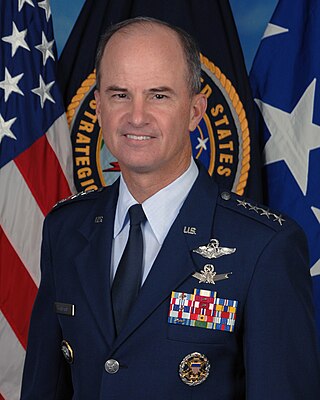
Kevin Patrick "Chilli" Chilton is an American mechanical engineer and retired United States Air Force four-star general, test pilot, and NASA astronaut. His last assignment was as commander of U.S. Strategic Command from October 3, 2007, to January 28, 2011. Prior to his appointment to general officer ranks, Chilton spent 11 years of his military career as a NASA astronaut. He retired from the Air Force on February 1, 2011, after having achieved the highest rank of any military astronaut. On January 30, 2012, General Chilton was named to the board of directors of Orbital Sciences Corporation.
Ent Air Force Base was a United States Air Force base located in the Knob Hill neighborhood of Colorado Springs, Colorado. A tent city, established in 1943 during construction of the base, was initially commanded by Major General Uzal Girard Ent (1900–1948), for whom the base is named. The base was opened in 1951.
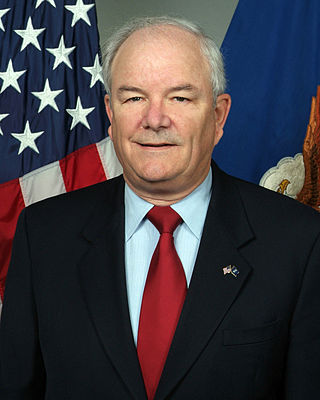
Michael Walter Wynne is an American politician and business executive and was the 21st United States Secretary of the Air Force. Secretary of Defense Robert Gates asked for and received his resignation on June 5, 2008, in the wake of the 2007 United States Air Force nuclear weapons incident and the mistaken shipment of Minuteman III parts to Taiwan in 2006, followed by an investigation by and a critical report from Admiral Kirkland H. Donald regarding the Minuteman incident.

The United States Air Force Academy Cemetery is a cemetery at the United States Air Force Academy in Colorado Springs, El Paso County, Colorado. It is administered by the 10th Air Base Wing.

Major General Roger Philip Lempke is a retired United States Air Force officer and was the adjutant general (TAG) of the Nebraska National Guard. The Nebraska Adjutant General commands the state military forces and also directs the Nebraska Emergency Management Agency (NEMA).

Space-based solar power is the concept of collecting solar power in outer space with solar power satellites (SPS) and distributing it to Earth. Its advantages include a higher collection of energy due to the lack of reflection and absorption by the atmosphere, the possibility of very little night, and a better ability to orient to face the Sun. Space-based solar power systems convert sunlight to some other form of energy which can be transmitted through the atmosphere to receivers on the Earth's surface.

General Gregory Stuart Martin is a retired U.S. Air Force general and Commander, Air Force Materiel Command at Wright-Patterson Air Force Base, Ohio. Martin was a command pilot with more than 4,600 flying hours in various aircraft, including the F-4, F-15, C-20 and C-21. Upon retirement in 2005, Martin took a position consulting for Northrop Grumman and also served on an Air Force panel studying stealth aircraft technology, among other Pentagon and private industry roles.

General James Erskine Hill was a World War II flying ace, United States Air Force general, and commander in chief of the North American Air Defense Command and the U.S. Air Force Aerospace Defense Command, with consolidated headquarters at Peterson Air Force Base, Colorado Springs, Colorado.

Radio is the technology of communicating using radio waves. Radio waves are electromagnetic waves of frequency between 3 hertz (Hz) and 300 gigahertz (GHz). They are generated by an electronic device called a transmitter connected to an antenna which radiates the waves. They are received by another antenna connected to a radio receiver. In addition to communication, radio is used for radar, radio navigation, remote control, remote sensing, and other applications.

Frank Graham Klotz served as Under Secretary of Energy for Nuclear Security and Administrator for the National Nuclear Security Administration of the U.S. Department of Energy. He was confirmed for the position on April 8, 2014, and retired on January 20, 2018.
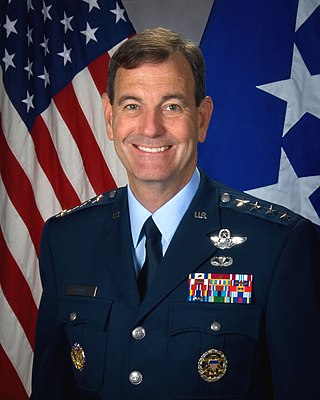
Stephen Randolph Lorenz, is a retired United States Air Force four-star general who currently serves as president and chief executive officer of the United States Air Force Academy Endowment. His last military assignment was as the 29th Commander, Air Education and Training Command (AETC), Randolph Air Force Base, Texas. As commander, he was responsible for the recruiting, training and education of all US Airmen. His command included the Air Force Recruiting Service, two numbered air forces and Air University. Air Education and Training Command consists of 13 bases, more than 92,000 active duty, reserve, guard, civilians and contractors, and 1,750 trainer, fighter and mobility aircraft.

Lieutenant General Michael Carl Gould is a retired senior officer of the United States Air Force who served as the 18th Superintendent of the United States Air Force Academy. He assumed command on June 9, 2009, and retired from service in July 2013. He previously served as director of operations and plans, United States Transportation Command, Scott Air Force Base. Gould is a command pilot with more than 3,000 hours in a variety of aircraft.

John L. "Jack" Hudson is a retired lieutenant general in the U.S. Air Force. He was Commander, Aeronautical Systems Center, Wright-Patterson Air Force Base, Ohio (WPAFB). Hudson also served as a member of the Senior Executive Service as the Director of the National Museum of the United States Air Force at WPAFB from 2009 to 2018.
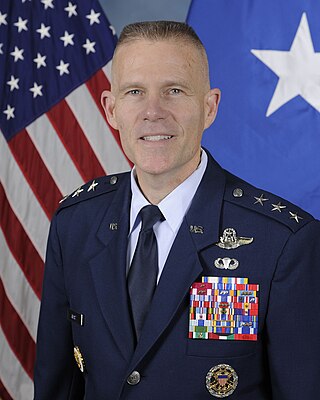
Steven Lloyd Kwast is a retired United States Air Force lieutenant general. He last served as commander of Air Education and Training Command, Joint Base San Antonio-Randolph, Texas. In that role, he was responsible for the recruiting, training and education of Air Force personnel. The command includes Air Force Recruiting Service, two numbered air forces and Air University. The command operates more than 1,400 trainer, fighter and mobility aircraft, 23 wings, 10 bases and five geographically separated groups. It trains more than 293,000 students per year with approximately 60,000 active-duty, Reserve, Guard, civilian and contractor personnel.

In computer networking, Energy-Efficient Ethernet (EEE) is a set of enhancements to twisted-pair, twinaxial, backplane, and optical fiber Ethernet physical-layer variants that reduce power consumption during periods of low data activity. The intention is to reduce power consumption by at least half, while retaining full compatibility with existing equipment.
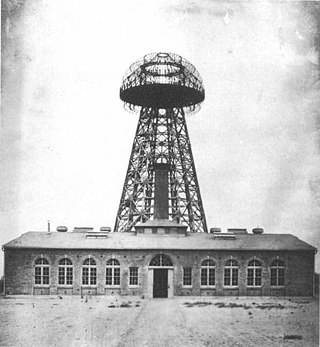
The World Wireless System was a turn of the 20th century proposed telecommunications and electrical power delivery system designed by inventor Nikola Tesla based on his theories of using Earth and its atmosphere as electrical conductors. He claimed this system would allow for "the transmission of electric energy without wires" on a global scale as well as point-to-point wireless telecommunications and broadcasting. He made public statements citing two related methods to accomplish this from the mid-1890s on. By the end of 1900 he had convinced banker J. P. Morgan to finance construction of a wireless station based on his ideas intended to transmit messages across the Atlantic to England and to ships at sea. His decision to change the design to include wireless power transmission to better compete with Guglielmo Marconi's new radio based telegraph system was met with Morgan's refusal to fund the changes. The project was abandoned in 1906, never to become operational.
Mastec, Inc. is an American multinational infrastructure engineering and construction company based in Coral Gables, Florida. The company provides engineering, building, installation, maintenance and upgrade of energy, utility and communications infrastructure. Its customers are primarily in the utility, communications and government industries.

Cheyenne Mountain Space Force Station (CMSFS) is located in Cheyenne Mountain on the Front Range of the Rocky Mountains in unincorporated El Paso County, Colorado, next to Colorado Springs, The Cheyenne Mountain Complex, an underground facility within Cheyenne Mountain SFS, was first built for the North American Aerospace Defense Command (NORAD) Combat Operations Center, though NORAD moved day-to-day operations to its headquarters on Peterson AFB in 2006. However, day-to-day operations were moved back in 2011 after a major overhaul and renovation.


















